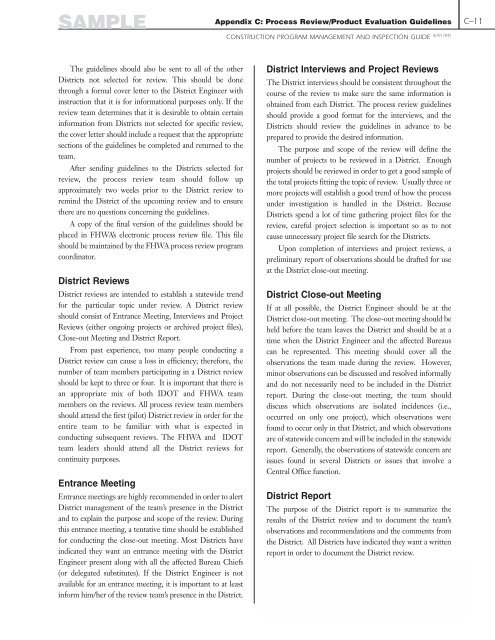Construction Program Management and Inspection Guide
Construction Program Management and Inspection Guide
Construction Program Management and Inspection Guide
Create successful ePaper yourself
Turn your PDF publications into a flip-book with our unique Google optimized e-Paper software.
SAMPLE<br />
The guidelines should also be sent to all of the other<br />
Districts not selected for review. This should be done<br />
through a formal cover letter to the District Engineer with<br />
instruction that it is for informational purposes only. If the<br />
review team determines that it is desirable to obtain certain<br />
information from Districts not selected for specific review,<br />
the cover letter should include a request that the appropriate<br />
sections of the guidelines be completed <strong>and</strong> returned to the<br />
team.<br />
After sending guidelines to the Districts selected for<br />
review, the process review team should follow up<br />
approximately two weeks prior to the District review to<br />
remind the District of the upcoming review <strong>and</strong> to ensure<br />
there are no questions concerning the guidelines.<br />
A copy of the final version of the guidelines should be<br />
placed in FHWA’s electronic process review file. This file<br />
should be maintained by the FHWA process review program<br />
coordinator.<br />
District Reviews<br />
District reviews are intended to establish a statewide trend<br />
for the particular topic under review. A District review<br />
should consist of Entrance Meeting, Interviews <strong>and</strong> Project<br />
Reviews (either ongoing projects or archived project files),<br />
Close-out Meeting <strong>and</strong> District Report.<br />
From past experience, too many people conducting a<br />
District review can cause a loss in efficiency; therefore, the<br />
number of team members participating in a District review<br />
should be kept to three or four. It is important that there is<br />
an appropriate mix of both IDOT <strong>and</strong> FHWA team<br />
members on the reviews. All process review team members<br />
should attend the first (pilot) District review in order for the<br />
entire team to be familiar with what is expected in<br />
conducting subsequent reviews. The FHWA <strong>and</strong> IDOT<br />
team leaders should attend all the District reviews for<br />
continuity purposes.<br />
Entrance Meeting<br />
Entrance meetings are highly recommended in order to alert<br />
District management of the team’s presence in the District<br />
<strong>and</strong> to explain the purpose <strong>and</strong> scope of the review. During<br />
this entrance meeting, a tentative time should be established<br />
for conducting the close-out meeting. Most Districts have<br />
indicated they want an entrance meeting with the District<br />
Engineer present along with all the affected Bureau Chiefs<br />
(or delegated substitutes). If the District Engineer is not<br />
available for an entrance meeting, it is important to at least<br />
inform him/her of the review team’s presence in the District.<br />
Appendix C: Process Review/Product Evaluation <strong>Guide</strong>lines<br />
CONSTRUCTION PROGRAM MANAGEMENT AND INSPECTION GUIDE (5/01/04)<br />
District Interviews <strong>and</strong> Project Reviews<br />
The District interviews should be consistent throughout the<br />
course of the review to make sure the same information is<br />
obtained from each District. The process review guidelines<br />
should provide a good format for the interviews, <strong>and</strong> the<br />
Districts should review the guidelines in advance to be<br />
prepared to provide the desired information.<br />
The purpose <strong>and</strong> scope of the review will define the<br />
number of projects to be reviewed in a District. Enough<br />
projects should be reviewed in order to get a good sample of<br />
the total projects fitting the topic of review. Usually three or<br />
more projects will establish a good trend of how the process<br />
under investigation is h<strong>and</strong>led in the District. Because<br />
Districts spend a lot of time gathering project files for the<br />
review, careful project selection is important so as to not<br />
cause unnecessary project file search for the Districts.<br />
Upon completion of interviews <strong>and</strong> project reviews, a<br />
preliminary report of observations should be drafted for use<br />
at the District close-out meeting.<br />
District Close-out Meeting<br />
If at all possible, the District Engineer should be at the<br />
District close-out meeting. The close-out meeting should be<br />
held before the team leaves the District <strong>and</strong> should be at a<br />
time when the District Engineer <strong>and</strong> the affected Bureaus<br />
can be represented. This meeting should cover all the<br />
observations the team made during the review. However,<br />
minor observations can be discussed <strong>and</strong> resolved informally<br />
<strong>and</strong> do not necessarily need to be included in the District<br />
report. During the close-out meeting, the team should<br />
discuss which observations are isolated incidences (i.e.,<br />
occurred on only one project), which observations were<br />
found to occur only in that District, <strong>and</strong> which observations<br />
are of statewide concern <strong>and</strong> will be included in the statewide<br />
report. Generally, the observations of statewide concern are<br />
issues found in several Districts or issues that involve a<br />
Central Office function.<br />
District Report<br />
The purpose of the District report is to summarize the<br />
results of the District review <strong>and</strong> to document the team’s<br />
observations <strong>and</strong> recommendations <strong>and</strong> the comments from<br />
the District. All Districts have indicated they want a written<br />
report in order to document the District review.<br />
C–11

















